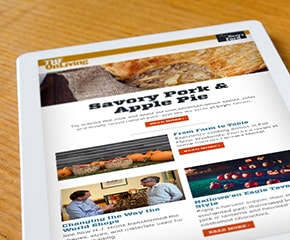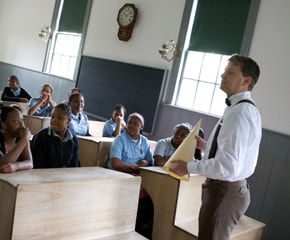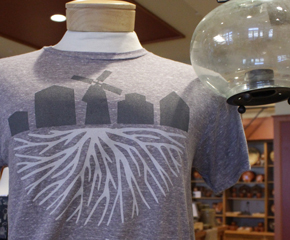What If
Despite any formal training in physics or engineering, Wilbur and Orville Wright brought an utterly original and successful approach to the problem of human flight. Isn’t it astonishing that all these secrets have been preserved for so many years just so we could discover them! Orville Wright, June 7, 1903
On December 8, 1903, Samuel Langley, Secretary of the Smithsonian Institution, prepared to launch his airplane over the Potomac River near Washington, D.C. Built with funding from the War Department and the Smithsonian, the aircraft – dubbed the “Aerodrome” – benefitted from Langley’s more than 15 years of flight research. But just seconds after launch, the Aerodrome plunged into the river.
Nine days later, on December 17, two obscure brothers from Ohio quietly won the race for powered flight. Wilbur and Orville Wright successfully piloted their heavier-than-air, powered Flyer in the remote Kill Devil Hills dunes, near Kitty Hawk, North Carolina. The Wrights, working alone and without so much as a high school diploma between them, solved a technical problem that had baffled the brightest minds for centuries.
Growing Up Wright
Milton and Susan Wright of Dayton, Ohio, encouraged intellectual curiosity, reading, experimentation, and tinkering in their home -- skills that shaped the methodical approach to problem solving used by their sons, Wilbur and Orville.


Milton, a Bishop of the Church of the United Brethren in Christ, traveled extensively and often brought back gifts for his children. One such present was a rubber band-powered flying toy, Pénaud’s Helicopter, which Milton brought home in 1878. The toy fascinated Wilbur and Orville and stimulated their first interest in flying machines.
From a young age, siblings Wilbur and Orville were inseparable. On one occasion Wilbur remarked,
“From the time we were little children, my brother Orville and myself lived together, played together, worked together, and, in fact, thought together. We usually owned all of our toys in common, talked over our thoughts and aspirations so that nearly everything that was done in our lives has been the result of conversations, suggestions, and discussions between us."
Wright Cycle Shop
Artifact
Store
Date Made
circa 1875
Summary
Wilbur and Orville Wright operated their bicycle business in this building from 1897 to 1908 in Dayton, Ohio. The brothers sold and repaired bikes, and they even produced models under their own brands. It was also in this shop that the Wright brothers built their earliest flying machines, including the 1903 Flyer that became the first successful heavier-than-air, powered, controlled aircraft.
Creators
Place of Creation
Keywords
Object ID
38.819.1
Credit
From the Collections of The Henry Ford.
Get more details in Digital Collections at:
Wright Cycle Shop
What is The Henry Ford?
The national attraction for discovering your ingenuity while exploring America’s spirit of innovation. There is always much to see and do at The Henry Ford.
They were also exceptionally close to their sister, Katharine, who played a critical role in their eventual successes. Wilbur said of Katharine, “if ever the world thinks of us in connection with aviation, it must remember our sister.” These three siblings remained in the family home most of their lives, with the brothers focusing on their many shared ventures in lieu of marriage. Wilbur and Orville established a printing shop in 1889, when they were 22 and 18 respectively. As the bicycle craze swept the country, the brothers bought bikes, learned to repair them, and in 1893 opened their own cycle shop. Eventually, they even sold bikes under their own brand names, but the majority of the shop’s income came from bicycle repairs.
By 1896, aeronautic enthusiasts were already drawing connections between the skills needed to bicycle and those needed to fly. Balance was essential to cycling, just as it would be to flying. Coincidentally, bicycling, via the Wright Cycle Shop, supported the brothers’ early aviation work, both financially and through the wood- and metalworking skills they honed there.
The Challenge of Control
In 1896 Germany’s Otto Lilienthal, the world leader in glider flight, died when his glider plunged to the ground. Lilienthal had completed more than 2,000 successful glider flights, and his fatal accident jolted aviation enthusiasts worldwide. Lilienthal’s sudden death reawakened the Wrights’ interest in aviation. They scoured local libraries for anything related to aeronautics. When those sources were exhausted, Wilbur penned a letter to the Smithsonian Institution on May 30, 1899, requesting more information about “mechanical and human flight.”
The brothers recognized that a successful flying machine required three things: wings to provide lift, an engine to provide propulsion, and a means for the pilot to control the aircraft in flight. The brothers saw little trouble with the first two points. Pioneers like Lilienthal seemingly had mastered wings with their gliders, and the fledgling automobile industry presumably could provide a suitable engine. The third point was the true challenge.
Aerodynamic control had received little study. Most people attempting to build flying machines were simply concerned with getting off the ground, and they attached little importance to control. However, without the ability to control direction and landing, manned flight would be too dangerous to be useful. To tackle the problem of control, the Wright brothers identified the three basic axes around which an airplane had to move: pitch (side-to-side or lateral axis), roll (front-to-back or longitudinal axis), and yaw (rotation around the vertical or perpendicular axis). A pilot must command the pitch, roll, and yaw of a flying machine in order to control it.
The Wright brothers studied birds and recognized that when turning or performing the roll motion, a bird simultaneously raised the tip of one wing while lowering the tip of the other. However, observing birds in flight never produced the “aha!” moment the brothers expected. Instead, the bicycle business clarified the problem of controlling roll, and ultimately, flight.
One evening in July 1899, alone in the cycle shop, Wilbur toyed with a rectangular bicycle inner-tube box, twisting it forward and backwards. The cardboard box performed the same motion as a bird in flight, and maintained stiffness, even when he twisted forcefully. Wilbur realized that by connecting the motion of a flying machine’s wings in relation to one another, twisting the axis of the wings in the same way a box twists or a bird flies, a pilot could control roll. This breakthrough, nicknamed “wing warping,” was the answer to controlled flight.
Testing Wing Lift with a Bicycle
The Wrights were now “fully afflicted with the belief that flight is possible to man,” as Wilbur wrote to Octave Chanute – a fellow aviation pioneer who would become a mentor. The brothers began testing with gliders. They asked the Weather Bureau where they might find optimal winds and discovered Kill Devil Hills, on the Atlantic Ocean near Kitty Hawk, North Carolina. The remote location offered privacy, open space, and plenty of soft sand on which to land. The seasonal nature of the bicycle business allowed the brothers to remain at Kitty Hawk for several weeks each year.
The Wrights shaped their wings based on calculations made by Lilienthal. The glider pioneer had created elaborate tables indicating just how much lift should be generated by a wing of a certain contour. Their first glider tests at Kitty Hawk, in 1900, were encouraging, but the wings did not produce as much lift as Lilienthal’s tables suggested. The Wrights returned in 1901 with larger wings, again shaped according to Lilienthal, but the new glider performed even worse. Disheartened, Wilbur exclaimed on the train ride home, “Not within a thousand years would man ever fly!”
The Wrights began to question Lilienthal’s data, and sought to check it through a series of experiments in Dayton. They created a test apparatus by mounting a wheel horizontally across the handlebars of a bicycle.


Reproduction of Wright Brothers' Wind Tunnel inside Wright Cycle Shop, Greenfield Village, 1938
 Details
Details
Reproduction of Wright Brothers' Wind Tunnel inside Wright Cycle Shop, Greenfield Village, 1938
Artifact
Photographic print
Summary
When their glider did not perform as expected in 1901, Wilbur and Orville Wright determined that the standard lift tables -- used to predict the lift generated by aircraft wings -- were incorrect. The Wrights built a wind tunnel in their Dayton bicycle shop and calculated their own tables. This new data led directly to their success with the 1903 Wright Flyer.
Place of Creation
Keywords
Object ID
EI.1929.P.A.2620
Credit
From the Collections of The Henry Ford.
On Exhibit
Not on exhibit to the public.
Get more details in Digital Collections at:
Reproduction of Wright Brothers' Wind Tunnel inside Wright Cycle Shop, Greenfield Village, 1938
What is The Henry Ford?
The national attraction for discovering your ingenuity while exploring America’s spirit of innovation. There is always much to see and do at The Henry Ford.
When the device did not act in accordance with Lilienthal’s data, the brothers knew they had found their culprit. The Wrights then built a wind tunnel consisting of a six-foot-long rectangular wooden box with a mechanized fan at one end, and a series of sensitive metal balances. Using model airfoils in the wind tunnel, Wilbur and Orville calculated their own lift tables. Their next glider, shaped by the new data, performed brilliantly at Kitty Hawk in 1902.
With control and lift solved, the Wrights turned to power. Though they had assumed that an adequate engine could be sourced “off the shelf” from an automaker, the Wrights could not find a satisfactory unit. Instead they worked with mechanic Charlie Taylor, whom they had hired to tend the cycle shop during their absences, to build a lightweight four-cylinder gasoline engine. With this final piece in place, the problems of lift, control, and propulsion were resolved.
Pioneering Aviation
Wilbur Wright Flying at Hunaudieres Race Course, Le Mans, France, August 1908
Artifact
Negative (Photograph)
Summary
Worried that rivals would steal their yet-to-be patented designs, the Wright brothers stopped flying publicly for nearly three years in late 1905. People began to doubt that the Wrights had ever flown. Skeptics were silenced in August 1908 when Wilbur Wright made a series of spectacular demonstration flights at Le Mans, France, achieving more distance and control than anyone else.
Creators
Place of Creation
Keywords
Object ID
2000.53.129
Credit
From the Collections of The Henry Ford.
Location
By Request in the Benson Ford Research Center
Get more details in Digital Collections at:
Wilbur Wright Flying at Hunaudieres Race Course, Le Mans, France, August 1908
What is The Henry Ford?
The national attraction for discovering your ingenuity while exploring America’s spirit of innovation. There is always much to see and do at The Henry Ford.
Near a quiet community on North Carolina’s outer banks, on December 17, 1903, Orville Wright became the first man to fly. That first flight lasted just 12 seconds and covered 120 feet, but later that day, Wilbur flew for 59 seconds over a distance of 852 feet.
The Wright brothers’ success was born out of years of painstaking work and attention to detail. Each problem they solved prepared them for the historic first flight. Like other innovators, the Wrights experienced their share of failures along the way, but they refused to let the setbacks stop them. With unfailing curiosity, methodical problem-solving, and perseverance through complications, the Wright brothers achieved what so many before them believed to be impossible.
Katherine White is Associate Curator, Digital Content at The Henry Ford.
Browse Collections
First Flight of Wright 1903 Flyer at Kill Devil Hills, North Carolina, December 17, 1903
Artifact
Photographic print
Summary
When John T. Daniels snapped the shutter on Orville Wright's camera, he captured one of the most significant images ever taken. The photo not only shows the moment of liftoff during the Wright brothers' first flight, but also the instant that heavier-than-air flight began. Daniels, a crewman at the Kill Devil Hills Life-Saving Station, had never used a camera before.
Creators
Object ID
82.300.1623.P.188.22016
Credit
From the Collections of The Henry Ford.
Location
By Request in the Benson Ford Research Center
Get more details in Digital Collections at:
First Flight of Wright 1903 Flyer at Kill Devil Hills, North Carolina, December 17, 1903
What is The Henry Ford?
The national attraction for discovering your ingenuity while exploring America’s spirit of innovation. There is always much to see and do at The Henry Ford.
Wright Home
Artifact
House
Date Made
1870
Summary
Though the Wright family moved around, brothers Wilbur and Orville always thought of this house, originally located at 7 Hawthorn Street in Dayton, Ohio, as home. Orville was born here in 1871, and Wilbur died here in 1912. It was also here that the brothers began their serious studies in aviation -- work that led to their successful 1903 Wright Flyer.
Creators
Place of Creation
Keywords
Object ID
38.820.1
Credit
From the Collections of The Henry Ford.
Get more details in Digital Collections at:
Wright Home
What is The Henry Ford?
The national attraction for discovering your ingenuity while exploring America’s spirit of innovation. There is always much to see and do at The Henry Ford.
Portrait of Wilbur Wright as a Boy, 1878
Artifact
Carte-de-visite (Card photograph)
Summary
Wilbur Wright was born on April 16, 1867, near Millville, Indiana. He was a strong student until an ice hockey accident as a teenager sunk him into a depression. Ironically, his mother's failing health brought Wilbur out of his melancholy as he cared for her in her final years. Instead of college, Wilbur educated himself through his father's extensive library.
Creators
Place of Creation
Object ID
62.167.2
Credit
From the Collections of The Henry Ford.
Location
By Request in the Benson Ford Research Center
Get more details in Digital Collections at:
Portrait of Wilbur Wright as a Boy, 1878
What is The Henry Ford?
The national attraction for discovering your ingenuity while exploring America’s spirit of innovation. There is always much to see and do at The Henry Ford.
Portrait of Orville Wright as a Boy, 1878
Artifact
Carte-de-visite (Card photograph)
Summary
Orville Wright was born on August 19, 1871, in the family house in Dayton, Ohio. In 1878 his father, a bishop who traveled frequently on church business, brought home a toy helicopter for Orville and his brother Wilbur. The Wright brothers later credited the toy with sparking their earliest interest in aviation.
Creators
Place of Creation
Object ID
62.167.3
Credit
From the Collections of The Henry Ford.
Location
By Request in the Benson Ford Research Center
Get more details in Digital Collections at:
Portrait of Orville Wright as a Boy, 1878
What is The Henry Ford?
The national attraction for discovering your ingenuity while exploring America’s spirit of innovation. There is always much to see and do at The Henry Ford.
Orville and Wilbur Wright at Their Home in Dayton, Ohio, circa 1910
Artifact
Photographic print
Summary
Wilbur and Orville Wright pose on the porch of the Wright family home in Dayton, Ohio. Neither of the brothers married or had children, and both continued to live with their father, Milton, and sister, Katharine. Without families of their own, the Wright brothers were free to devote increasing amounts of time and money to their aviation experiments.
Keywords
Object ID
84.1.1660.P.188.22519
Credit
From the Collections of The Henry Ford. Gift of Ford Motor Company.
Location
By Request in the Benson Ford Research Center
Get more details in Digital Collections at:
Orville and Wilbur Wright at Their Home in Dayton, Ohio, circa 1910
What is The Henry Ford?
The national attraction for discovering your ingenuity while exploring America’s spirit of innovation. There is always much to see and do at The Henry Ford.
Orville Wright, Katharine Wright and Wilbur Wright in France, 1909
Artifact
Photographic print
Summary
Orville Wright and Katharine Wright joined their brother, Wilbur, in France in early 1909. Wilbur had completed a series of impressive demonstration flights the previous fall, and the three siblings were celebrated throughout the country as heroes. Despite all the attention from monarchs, politicians, and business titans, the Wrights remained unaffectedly true to their Midwestern modesty.
Keywords
Object ID
82.300.1623.P.188.20982
Credit
From the Collections of The Henry Ford.
Location
By Request in the Benson Ford Research Center
Get more details in Digital Collections at:
Orville Wright, Katharine Wright and Wilbur Wright in France, 1909
What is The Henry Ford?
The national attraction for discovering your ingenuity while exploring America’s spirit of innovation. There is always much to see and do at The Henry Ford.
Wright Cycle Shop in Dayton, Ohio, 1936
Artifact
Photographic print
Date Made
1936
Summary
Before moving the Wright Cycle Shop from Dayton, Ohio, to Greenfield Village in November 1936, Henry Ford's agents collected old images and took detailed photographs of the building. These photos helped the team reassemble the structure in Dearborn, Michigan. Orville Wright and Charlie Taylor, the mechanic who built the engine for the 1903 Flyer, also assisted to ensure the reconstruction's accuracy.
Keywords
Object ID
P.B.94167
Credit
From the Collections of The Henry Ford.
On Exhibit
Not on exhibit to the public.
Related Objects
Get more details in Digital Collections at:
Wright Cycle Shop in Dayton, Ohio, 1936
What is The Henry Ford?
The national attraction for discovering your ingenuity while exploring America’s spirit of innovation. There is always much to see and do at The Henry Ford.

Discussion Questions
- What or who motivated the Wright brothers to innovate?
- What traits of an innovator did the Wright brothers illustrate?
- Which of these traits do you think was most important to their success inventing the first flying machine?
- Do you think you could solve transportation problems of today with some of the same approaches made famous by the Wright brothers? What transportation problem would you want to solve?
- Do you think you can be an innovator like the Wright brothers? Why or why not?
Fuel Your Enthusiasm
The Henry Ford aims to provide unique educational experiences based on authentic artifacts, stories and lives from America’s tradition of ingenuity, resourcefulness, and innovation. Connect to more great educational resources:

































